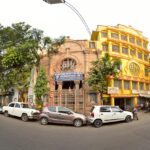SRI DHARMARAJIKA CHETIYA VIHARA
In 1914 Anagarika Dharmapala purchased a plot of land at College Square and at this plot the foundation stone of the Sri Dharmarajika Vihara was laid on the 16th December, 1918.
In 1916, the Government of India agreed to offer the Maha Bodhi Society a sacred Holy Relic of the Buddha which had been discovered during the excavations of Bhattiprolu stupa in Madras Presidence provided the Society erected asuitable Vihara in Calcutta.
The construction of the Vihara was completed in 1920. The main donor to the Vihara fund was Mrs T.R. Foster, who contri- buted a total amount of Rs.63,606 and the ruler of Baroda contributed Rs.5,685 and another Rs.5,000 for purchasing an adjoining plot to the East of Vihara, M/s Birla Brothers also contributed Rs.5,000 to the Vihara Fund.
So, Anagarika Dharmapala’s long- cherished desire for building a suitable Vihara was at last fulfilled. Dharmarajika Vihara was opened on the 20th November 1920 at an impressiveceremony.
As planned for the occasion on the morning of the 20th November Sir Ashutosh Mukherji along with Anagarika Dharmapala and Mrs Annie Besant arrived at the Government House followed by a colourful procession con- sisting of Burmese, Sinhalese, Chinese, Japanese, Siamese and Indian Buddhist monks and a concourse of about two thousand people. His Excellency Lord Ronaldshay, the Governor of Bengal handed over the Relic contained in a crystal casket to Sir Ashutosh Mukherji. He han- ded over the same to Anagarika Dharmapala who placed the casket on the throne placed in a carriage drawn by six horses. The procession returned to Dharmarajika Vihara and the Relic was enshrined in the specially prepared stupa.
In the evening the opening ceremony was held under the Presidentship of Lord Ronaldshay in the presence of a distinguished gathering. Sir Ashutosh Mukherji gave the address of welcome and after the speeches delivered by Anagarika and other eminent guests Lord Ronaldshay in his eloquent speech said, “The ceremony for which we are gathered together today is one which will surely prove to be of historic interest, for it bears witness to a definite revival of Buddhism in a land which while once a famous centre of the doctrine has been bereft of it outwardly at least for nigh upon eight centuries… It is not necessary to be an actual adherent of the Buddhist faith to be an reverent admirer of the life and teachings of its founder. And it may not be out of place, perhaps on such an occasion as this that I, an adherent of a different faith, should pay to Buddhism my tribute of respect and admiration.” Justice Woodroffe, the eminent Sanskrit Scholar proposed a vote of thanks.
The opening of a permanent vihara at such a central place in Calcutta was a great step forward for the Society in fulfilling its mission for the regeneration of Buddha’s teachings. Regular meetings for the propagation of the ideals of Buddhism and religious ceremonies on Buddhist festivals began to be held with devotion and enthusiasm. The response from the eminent persons particularly the Bengali intelligentsia was encouraging. The proximity of the headquarters of the Society to the Calcutta University situated on the opposite side of College Square and the distinct influence of Sir Ashutosh’s Presidentship of the Society helped in securing co-operation of the Professors and scholars of the University.
